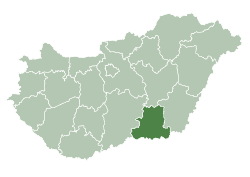Szeged
Szeged (/ˈsɛɡɛd/ SEG-ed, Hungarian: [ˈsɛɡɛd] (![]()
Szeged | |
|---|---|
| Szeged Megyei Jogú Város | |
  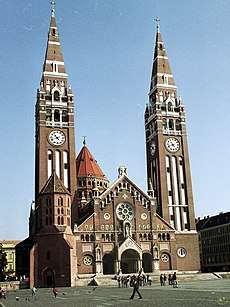  Top: A view of riverside in Tisza and nearby Mora Museum and Szeged National Theater, Middle left: A monument house in Klauzai Square, Center: Szeged Water Tower, Middle right:Szeged Csanad Cathedral in Dom Square, Bottom left: Szeged City Office, Bottom right: Szeged National Theater in Vaszy Vikor Square | |
 Flag  Coat of arms | |
| Nickname(s): City of Sunshine (Napfény városa) | |
 Szeged  Szeged  Szeged | |
| Coordinates: 46.255°N 20.145°E | |
| Country | |
| Region | Southern Great Plain |
| County | Csongrád |
| District | Szeged |
| City status | 1498 |
| Government | |
| • Mayor | László Botka (Independent) |
| • Deputy mayor | List[1]
|
| • Town Notary | Dr Andrea Gál |
| Area | |
| • City with county rights | 280.84 km2 (108.43 sq mi) |
| Area rank | 11th in Hungary |
| Elevation | 76 m (249.34 ft) |
| Highest elevation | 76.7 m (251.6 ft) |
| Lowest elevation | 75.8 m (248.7 ft) |
| Population (2019) | |
| • City with county rights | 160,766[2] |
| • Rank | 3rd in Hungary |
| • Density | 612.28/km2 (1,585.8/sq mi) |
| • Urban | 239,025 (7th)[3] |
| Demonym(s) | szegedi |
| Population by ethnicity | |
| • Hungarians | 83.9% |
| • Romani | 0.9% |
| • Germans | 0.9% |
| • Serbs | 0.8% |
| • Romanians | 0.3% |
| • Slovaks | 0.2% |
| • Greeks | 0.1% |
| • Other | 2.1% |
| Population by religion | |
| • Roman Catholic | 36.4% |
| • Greek Catholic | 0.4% |
| • Calvinists | 4.8% |
| • Lutherans | 1.2% |
| • Jews | 0.1% |
| • Other | 2.4% |
| • Non-religious | 23.4% |
| • Unknown | 31.4% |
| Time zone | UTC+01:00 (CET) |
| • Summer (DST) | UTC+02:00 (CEST) |
| Postal code | 6700 to 6729, 6753, 6757, 6771, 6791 |
| Area code | (+36) 62 |
| Motorways | M5 Motorway M43 Motorway |
| NUTS 3 code | HU333 |
| Distance from Budapest | 162.8 km (101.2 mi) Northwest |
| Airport | Szeged (LHUD) |
| MPs | List
|
| Website | www |
The Szeged Open Air (Theatre) Festival (first held in 1931) is one of the main attractions, held every summer and celebrated as the Day of the City on 21 May.
Etymology
The name Szeged might come from an old Hungarian word for 'corner' (szeg), pointing to the turn of the river Tisza that flows through the city. Others say it derives from the Hungarian word sziget which means 'island'. Others still contend that szeg means 'dark blond' (sötétszőkés) – a reference to the color of the water where the rivers Tisza and Maros merge.[5]
The city has its own name in a number of foreign languages, usually by adding a suffix -in to the Hungarian name: Croatian Segedin; Romanian Seghedin; Bulgarian, Belarusian, Russian and Ukrainian Сегед (Seged); German Szegedin or Segedin; Greek Παρτίσκον (Partiscum); Italian Seghedino; Latin Partiscum; Latvian Segeda; Lithuanian Segedas; Polish Segedyn; Serbian Сегедин (Segedin); Slovak and Czech Segedín; Turkish Segedin.
History
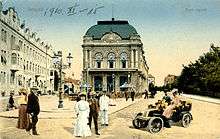
Szeged and its area have been inhabited since ancient times. Ptolemy mentions the oldest known name of the city: Partiscum. It is possible that Attila, king of the Huns had his seat somewhere in this area. The name Szeged was first mentioned in 1183, in a document of King Béla III.
In the second century AD there was a Roman trading post established on an island in the Tisza, and the foundations of the Szeged castle suggest that the structure may have been built over an even earlier fort. Today only one corner of the castle still remains standing.[6]
During the Mongol invasion the town was destroyed and its inhabitants fled to the nearby swamps, but they soon returned and rebuilt their town. In the 14th century, during the reign of Louis the Great, Szeged became the most important town of Southern Hungary, and – as the Turkish armies got closer to Hungary – the strategic importance of Szeged grew. King Sigismund of Luxembourg had a wall built around the town. Szeged was raised to free royal town status in 1498.
Szeged was first pillaged by the Turkish army on 28 September 1526, but was occupied only in 1543, and became an administrative centre of the Ottomans (see Ottoman Hungary). The town was a sanjak centre first in Budin Eyaleti (1543–1596), after in Eğri Eyaleti. The town was freed from Turkish rule on 23 October 1686, and regained the free royal town status in 1715. In 1719, Szeged received its coat of arms (still used today) from Charles III. During the next several years, Szeged grew and prospered. Piarist monks arrived in Szeged in 1719 and opened a new grammar school in 1721. Szeged also held scientific lectures and theatrical plays. These years brought not only prosperity but also enlightenment. Between 1728 and 1744 witch trials were frequent in the town, with the Szeged witch trials of 1728–29 perhaps being the largest. The witch trials were instigated by the authorities, who decided on this measure to remove the problem of the public complaints about the drought and its consequences of famine and epidemics by laying the responsibility on people among them, which had fraternized with the Devil. In 1720, the ethnic Hungarian population of the town numbered about 13000 to 16000, while the number of the Serb inhabitants was 1300.[7]
Szeged is known as the home of paprika, a spice made from dried, powdered capsicum fruits. Paprika arrived in Hungary in the second half of the 16th century as an ornamental plant. About 100 years later the plant was cultivated as an herb, and paprika as we know it.[8] Szeged is also famous for their szekelygulyas, a goulash made with pork, sauerkraut and sour cream.[9] And also famous for their halászlé, fish soup made of carp and catfish.
The citizens of Szeged played an important part in the Hungarian Revolution of 1848. Lajos Kossuth delivered his famous speech here. Szeged was the last seat of the revolutionary government in July 1849. The Habsburg rulers punished the leaders of the town, but later Szeged began to prosper again; the railway reached it in 1854, and the town got its free royal town status back in 1860. Mark Pick's shop – the predecessor of today's Pick Salami Factory – was opened in 1869.
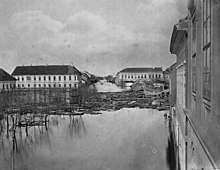
Today the inner city of Szeged has wide avenues. This is mainly due to the great flood of 1879, which wiped away the whole town (only 265 of the 5723 houses remained and 165 people died). Emperor Franz Joseph visited the town and promised that "Szeged will be more beautiful than it used to be". He kept his promise, and during the next years a new, modern city emerged from the ruins, with palaces and wide streets.
During the 20th century
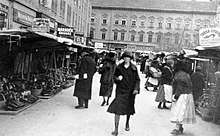
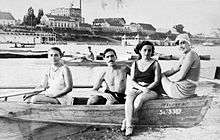
After the First World War Hungary lost its southern territories to Serbia, as a result Szeged became a city close to the border, and its importance lessened, but as it took over roles that formerly belonged to the now lost cities, it slowly recovered. Following the Loss of Transylvania to Romania, University of Kolozsvár (now Cluj-Napoca), moved to Szeged in 1921 (see University of Szeged). In 1923 Szeged took over the role of episcopal seat from Temesvár (now Timișoara, Romania). It was briefly occupied by the Romanian army during Hungarian-Romanian War in 1919. During the 1920s the Jewish population of Szeged grew and reached its zenith.
Szeged suffered heavily during World War II. 6,000 inhabitants of the city were killed, the Jewish citizens were confined to ghettos and then taken to death camps. Szeged was captured by Soviet troops of the 2nd Ukrainian Front on 11 October 1944 in the course of the Battle of Debrecen. During the communist era, Szeged became a centre of light industry and food industry. In 1965 oil was found near the city.
In 1962, Szeged became the county seat of Csongrád. Whole new districts were built, and many nearby villages (e.g. Tápé, Szőreg, Kiskundorozsma, Szentmihálytelek, Gyálarét) were annexed to the city in 1973 (as was a tendency during the Communist era).
Today's Szeged is an important university town and a tourist attraction.
The Szeged Symphony Orchestra (Szegedi Szimfonikus Zenekar) gives regular concerts at the Szegedi Nemzeti Színház.[10]
Geography
Szeged is situated near the southern border of Hungary, just to the south of the mouth of the Maros River, on both banks of the Tisza River, nearly in the centre of the Carpathian Basin. The Hungarian frontier with Serbia is just outside the town.
Climate
Szeged's climate is transitional between oceanic Köppen "Cfb" (Marine West Coast Climate/Oceanic climate) and continental (Köppen Dfb), with cold winters, hot summers, and fairly low precipitation. Due to the high hours of sunlight reported annually, Szeged is often called City of Sunshine (Napfény városa).[11]
| Climate data for Szeged (1971–2000) | |||||||||||||
|---|---|---|---|---|---|---|---|---|---|---|---|---|---|
| Month | Jan | Feb | Mar | Apr | May | Jun | Jul | Aug | Sep | Oct | Nov | Dec | Year |
| Average high °C (°F) | 2.8 (37.0) |
5.7 (42.3) |
11.6 (52.9) |
16.9 (62.4) |
22.4 (72.3) |
25.5 (77.9) |
27.7 (81.9) |
27.6 (81.7) |
23.3 (73.9) |
17.2 (63.0) |
8.9 (48.0) |
4.1 (39.4) |
16.1 (61.1) |
| Daily mean °C (°F) | −0.8 (30.6) |
1.2 (34.2) |
5.9 (42.6) |
10.8 (51.4) |
16.3 (61.3) |
19.2 (66.6) |
20.8 (69.4) |
20.8 (69.4) |
16.4 (61.5) |
11.0 (51.8) |
4.7 (40.5) |
0.9 (33.6) |
10.6 (51.1) |
| Average low °C (°F) | −3.8 (25.2) |
−2.6 (27.3) |
0.5 (32.9) |
5.2 (41.4) |
10.3 (50.5) |
13.0 (55.4) |
14.3 (57.7) |
14.0 (57.2) |
10.3 (50.5) |
5.6 (42.1) |
1.2 (34.2) |
−2.0 (28.4) |
5.5 (41.9) |
| Average precipitation mm (inches) | 24 (0.9) |
23 (0.9) |
25 (1.0) |
40 (1.6) |
51 (2.0) |
68 (2.7) |
53 (2.1) |
56 (2.2) |
37 (1.5) |
35 (1.4) |
38 (1.5) |
39 (1.5) |
489 (19.3) |
| Mean monthly sunshine hours | 59 | 94 | 143 | 173 | 234 | 252 | 278 | 263 | 199 | 153 | 77 | 53 | 1,978 |
| Source: Hungarian Meteorological Service[12] | |||||||||||||
Education
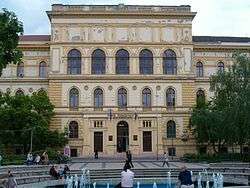
The city of Szeged has 62 kindergartens, 32 elementary schools and 18 high schools. The two most prominent high schools (Ságvári Endre Gyakorló Gimnázium and Radnóti Miklós Kísérleti Gimnázium) are in the top fifteen in the country.
Szeged is the higher education centre of the Southern Great Plain and has built quite a reputation for itself. Thousands of students study here, many of whom are foreigners. The University of Szeged is according to the number of students the second largest and the 4th oldest university of Hungary being established in 1581. Ranked as the top university of the country on Academic Ranking of World Universities – 2005, and in the top 100 in Europe, it offers several programs on different fields of study.
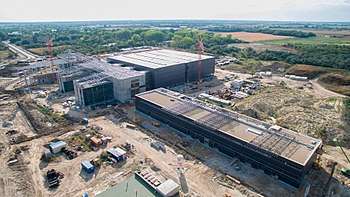
The Biological Research Centre of the Hungarian Academy of Sciences, which was built with the help of UNESCO funds, has also been a considerable source of advanced research. Scientists at this laboratory were first in the world to produce artificial heredity material in the year 2000. The building has served as a home to many well known conferences and continues to make contributions to the world of science.
The Szent-Györgyi Albert Agóra is a cultural scientific centre of Szeged which gives home to laboratories of the Biological Research Centre and to exhibitions of the John von Neumann Computer Society especially their IT historical exposition.
In 2018 the new scientific institution, the ELI Attosecond Light Pulse Source (ELI-ALPS) opened in Szeged establishing a unique facility which provides light sources within an extremely broad frequency range in the form of ultrashort pulses with high repetition rate which is needed for different kinds of physical experiments especially in the field of attosecond physics.[13]
Demographics
| Year | Pop. | ±% |
|---|---|---|
| 1870 | 56,901 | — |
| 1880 | 59,143 | +3.9% |
| 1890 | 68,924 | +16.5% |
| 1900 | 82,803 | +20.1% |
| 1910 | 96,063 | +16.0% |
| 1920 | 100,175 | +4.3% |
| 1930 | 108,448 | +8.3% |
| 1941 | 110,740 | +2.1% |
| 1949 | 104,867 | −5.3% |
| 1960 | 117,515 | +12.1% |
| 1970 | 145,312 | +23.7% |
| 1980 | 164,437 | +13.2% |
| 1990 | 169,930 | +3.3% |
| 2001 | 168,273 | −1.0% |
| 2011 | 168,048 | −0.1% |
| 2019 | 160,766 | −4.3% |
Ethnic groups (2001 census):
- Hungarians – 93.5%
- Romani – 0.7%
- Germans – 0.5%
- Serbs – 0.2%
- Romanians – 0.2%
- Croats – 0.1%
- Slovaks – 0.1%
- No answer (unknown) – 4.7%
Religions (2001 census):
Economy
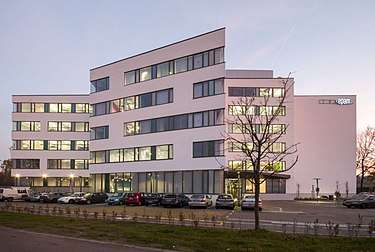
Szeged is one of the centres of food industry in Hungary, especially known for its paprika and companies like Pick Szeged, Sole-Mizo, Bonafarm etc. Other notable companies having their headquarters in Szeged are AMSY International,[14] RRE – Szeged,[15] Optiwella,[16] Generál Printing House,[17] RotaPack,[18] Sanex Pro,[19] Agroplanta,[20] Karotin,[21] Florin,[22] Quadrotex[23] and SZEPLAST.[24]
Others, like ContiTech,[25] Duna-Dráva Cement, Szatmári Malom[26] and Europe Match,[27] are not based in the city, but have production facilities there.
The Hangár Expo and Conference Centre[28] provides space for international exhibitions and conferences.
Largest employers
| # | Employer | # of Employees |
|---|---|---|
| 1 | University of Szeged | 5,000 < |
| 2 | Pick Szeged | 2,000–4,999 |
| 3 | Sole-Mizo | 1,000–1,999 |
| 4 | Tisza-Volán | 1,000–1,999 |
| 5 | EDF-Démász | 500–999 |
| 6 | Suli-Host | 500–999 |
| 7 | Szegedi Közlekedési Társaság | 500–999 |
| 8 | Szegedi Szefo | 500–999 |
| 9 | Coop | 300–499 |
| 10 | GDF Suez | 300–499 |
| Year | Unemployment rate (%) |
|---|---|
| 2000 | 5.17% |
| 2001 | 4.83% |
| 2002 | 4.22% |
| 2003 | 4.32% |
| 2004 | 4.67% |
| 2005 | 5.01% |
| 2006 | 4.89% |
| 2007 | 4.25% |
| 2008 | 4.60% |
| 2009 | 4.91% |
| 2010 | 6.26% |
| 2011 | 6.50% |
| 2012 | 6.42% |
| 2013 | 6.89% |
| 2014 | 4.17% |
| 2015 | 4.42% |
| 2016 | 4.14% |
Sport
The most popular sport in the city is handball. The city has one well-known club the 2013–14 EHF Cup-winner SC Pick Szeged playing in the Nemzeti Bajnokság I.
The second most popular sport is football in the city. Szeged had several clubs playing in the top level Hungarian league, the Nemzeti Bajnokság I. These are Szegedi AK, Szegedi Honvéd SE. The only currently operating club, Szeged 2011 play in the Nemzeti Bajnokság II.
Association football clubs
- Szeged 2011, currently competing in the 2018–19 Nemzeti Bajnokság III
- Szegedi Egységes Oktatási Labdarúgó SC, currently competing in the 2018–19 Nemzeti Bajnokság III
- Szegedi VSE, currently competing in the Csongrád county championship
- Szegedi EAC, defunct
- Szegedi AK, defunct
- Szegedi Honvéd SE, defunct
Main sights
| Votive Church (1930) | 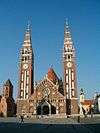 |
Dömötör Tower (11th century) | The Water Tower of Szent István Square (1904) | ||
| Church of Grey Friars (Gothic, 15th century) |  |
Ferenc Móra Museum (1896) | Reök palace (1907) | 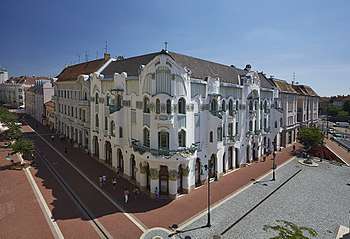 | |
| City Hall (1728, 1804, 1883) | Szeged Synagogue | 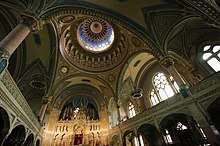 |
National Theatre of Szeged |  | |
| Gróf-palace (1913) |  |
The Main Building of the University |  |
Saint Nicholas Serbian Orthodox Church (1781) |
Politics
The current mayor of Szeged is László Botka (Association for Szeged).
The local Municipal Assembly, elected at the 2019 local government elections, is made up of 33 members (1 Mayor, 23 Individual constituencies MEPs and 9 Compensation List MEPs) divided into this political parties and alliances:[31]
| Party | Seats | Current Municipal Assembly | |||||||||||||||||||
|---|---|---|---|---|---|---|---|---|---|---|---|---|---|---|---|---|---|---|---|---|---|
| Association for Szeged[lower-alpha 1] | 19 | M | |||||||||||||||||||
| Fidesz-KDNP | 9 | ||||||||||||||||||||
| Independent Hungarian City Association (FVSZME) | 1 | ||||||||||||||||||||
List of mayors
List of City Mayors from 1990:[32]
| Member | Party | Term of office | |
|---|---|---|---|
| Pál Lippai | Fidesz-SZDSZ | 1990–1994 | |
| István Szalay | MSZP | 1994–1998 | |
| László Bartha | Fidesz-FKgP-MDF | 1998–2002 | |
| László Botka | MSZP | 2002– | |
| Independent[lower-alpha 1] | |||
Media
The city offers a wide range of media – television and radio stations, and print and online newspapers.
TV stations
- Szeged TV
- Tarjáni Kábeltévé Stúdió
- TiszapART TV
- Telin Televízió
Radio stations
- "Rádió 88" FM 95,4 MHz
- All in Party Radio
- Rádió Mi, 89,9 MHz
- Lánchíd Rádió, FM 100,2 MHz
- MR1 Kossuth Rádió, FM 90,3 MHz
- MR2 Petőfi Rádió, 104,6 MHz
- MR3 Bartók Rádió, 105,7 MHz
- Dankó Rádió, 93,1 MHz
- Rádió1, 87,9 MHz
Daily newspapers and news portals
- Délmagyarország (delmagyar
.hu ) - szeged
.hu - szegedma
.hu
Notable people
Born in Szeged
- Adrián Annus (1975), hammer thrower
- Gábor Agárdy (1922–2006), actor
- Béla Balázs (1884–1949), writer, poet, film critic
- Zsolt Becsey (1964), politician
- Joseph Csaky (1888–1971) sculptor
- Krisztián Cser (1977) opera singer, physicist
- Attila Czene (1974), Olympic champion medley swimmer
- János Csonka (1852–1939), engineer, co-inventor of the carburetor
- Mihály Erdélyi (1895–1979), operetta composer
- Sophie Evans (1976), adult movie star
- Ivan Fellegi (1935), Chief Statistician of Canada
- Rajmund Fodor (1976), Olympic champion water polo player
- Jenő Huszka (1875–1960), composer
- Éva Janikovszky (1926–2003), writer
- Ferenc Joachim (1882–1964), painter
- Gyula Juhász (1883–1937), poet
- Esther Jungreis, Orthodox Jewish outreach speaker
- Judith Karasz (1912–1977), photographer and Bauhaus graduate
- Moses Max Löw (1857–?), architect
- Géza Maróczy (1870–1951), chess grand master
- Anita Márton (1989), shot putter
- Tamás Molnár (1975), Olympic champion water polo player
- Nickolas Muray (born Miklós Mandl; 1892–1965), Hungarian-born American photographer and Olympic fencer
- Róbert Nagy (1967), speedway rider
- László Paskai (1927–2015), Archbishop of Esztergom
- Szilvia Peter Szabo (1982), singer
- Willy Pogany (1882–1955), illustrator
- György Sebők (1922–1999), pianist
- Julius Stahel (1825–1912), American Civil War general and diplomat
- Hanna Tetteh (1967), Foreign minister of the Republic of Ghana
- Péter Ágnes (1983), singer
- Attila Vajda (1983), Olympic champion canoer
- Vilmos Zsigmond (1930), cinematographer
Who lived in Szeged
- Mihály Babits poet, writer
- Lipót Fejér mathematician
- Alfréd Haar mathematician
- Attila József poet
- László Kalmár mathematician
- Dezső Kosztolányi poet, novelist
- Leopold Löw rabbi, historian and Judaic scholar
- Immanuel Löw rabbi, Judaic scholar, politician
- Kálmán Mikszáth writer
- Ferenc Móra writer, archaeologist
- Miklós Radnóti poet
- Frigyes Riesz mathematician
- Albert Szent-Györgyi Nobel prize winner chemist and biologist
- Béla Szőkefalvi-Nagy mathematician
- Peter Leko chess grandmaster
- Ferenc Fricsay conductor
- Adele Zay (1848–1928), teacher and feminist
Gallery
 Szeged City Hall.
Szeged City Hall. Posta Palace.
Posta Palace. MÁV Palace.
MÁV Palace. Votive Church at night.
Votive Church at night.- Matthias Corvinus of Hungary.
 Elisabeth (Sisi) was Empress of Austria and Queen of Hungary.
Elisabeth (Sisi) was Empress of Austria and Queen of Hungary.- Unger–Mayer House (1911).
- Statue of Kuno Klebelsberg.

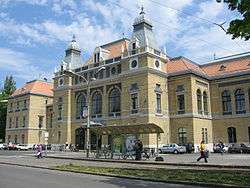 Szeged Railway Station.
Szeged Railway Station. The Great Flood (1879) Statue.
The Great Flood (1879) Statue. Rector's Building, University of Szeged
Rector's Building, University of Szeged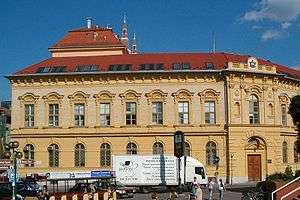 Institute of Informatics & IT Department, University of Szeged
Institute of Informatics & IT Department, University of Szeged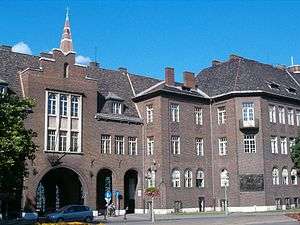 Faculty of Sciences (the chemistry building), University of Szeged
Faculty of Sciences (the chemistry building), University of Szeged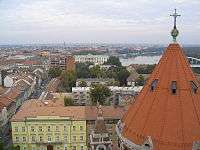 View from Votive Church Dome.
View from Votive Church Dome. Aerial photography.
Aerial photography.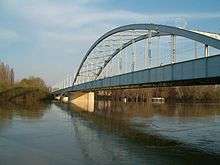 Belvárosi bridge on the Tisza river
Belvárosi bridge on the Tisza river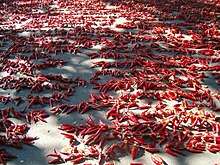 Capsicum fruits in Szeged.
Capsicum fruits in Szeged.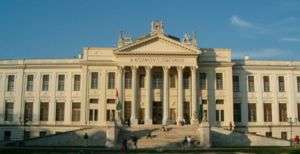 Móra Ferenc Museum.
Móra Ferenc Museum. Anna Thermal-Bath.
Anna Thermal-Bath. Szeged bridge on Tisza.
Szeged bridge on Tisza.
 Fekete-house
Fekete-house
Twin towns – Sister cities
Szeged is twinned with:
Transport

Szeged is the most important transportation hub in the Southern Great Plain. Two motorways, M5 and M43, lie along the city border. Through the M5 Motorway Szeged is connected to Kecskemét, Kiskunfélegyháza and Budapest in the north direction and to Subotica, Novi Sad and Beograd in Serbia in the south direction. Thanks to the M43 Motorway – which splits from the M5 Motorway near Szeged – goes near Makó to Arad and Timișoara in Romania. In addition, there are other roads running from the city to Makó and Nagylak (Mainroad 43), to Röszke (Mainroad 5), to Kiskunfélegyháza (Mainroad 5), to Ásotthalom and Baja (Mainroad 55) and to Hódmezővásárhely, Orosháza and Békéscsaba (Mainroad 47).
The Budapest-Szeged-rail line is an important rail connection, as well as the Railwaylines 121 (to Makó), 135 (to Hódmezővásárhely), 136 (to Röszke) and 140 (to Kiskunfélegyháza).[37]
A tram-train system is under construction to connect Szeged with the neighbouring Hódmezővásárhely and possibly Makó, thus creating the second most populous urban agglomeration in the country, after the capital. There was a proposal for its extension, even through the Serbian border, to Subotica.
The city is also a common stop for national and international long-distance buses.
Railways
- 121 (to Makó)
- 135 (to Hódmezővásárhely)
- 136 (to Röszke)
- 140 (to Kiskunfélegyháza).
Airport
Szeged Airport is the international airport of Szeged.
Public transport
As of May 2018 Szeged had 39 local bus lines – 15 in the city centre and 24 in the suburbs. While there were also 5 tram lines.[38]
References
- Pécs – Tisztségviselők
- KSH, 2019
- "OECD – FUNCTIONAL URBAN AREAS IN OECD COUNTRIES: HUNGARY" (PDF).
- "Detailed Gazetteer of Hungary". www.ksh.hu.
- "On etymology". Archived from the original on 18 October 2007.
- Szeged by Dr. Trogmayer Ottó
- Ádám Fejér, Magyarok és szlávok. (Konferencia, Szeged, 1991. május 30-31). Szerk. Fejér Ádám, H. Tóth Imre stb. (Kiad. a JATE Szláv Filológiai Tansz.), József Attila Tudományegyetem, 1993, p. 262, ISBN 9789634819929
- "Vickery TV Paprika (Hungary)". 28 July 2009. Archived from the original on 28 July 2009.
- "TalkTalk Webspace is closing soon!!". www.talktalk.co.uk.
- Szeged Symphony Orchestra website, accessed 6 August 2012.
- Kft, New Wave Media Group. "A napfény városa". https://www.origo.hu/. External link in
|website=(help) - "Monthly Averages for Szeged 1971–2000". met.hu.
- "ELI-ALPS Research Institute | Towards the sharp end of attoscience". www.eli-alps.hu.
- "Contact Info – AMSY". www.amsy.net.
- "RRE – Szeged Nyomdaipari kft. – Elérhetőségek".
- "Optiwella | Docsis Cable Modems & CMTS". www.optiwella.com.
- "Contact Us". generalnyomda.hu.
- "RotaPack – Contact".
- "SanexPro". sanexpro.hu.
- "AgroPlantaKft Szeged". agroplanta.hu.
- "Kapcsolat". karotin.hu.
- "Kapcsolat – Florin".
- "Kapcsolat". www.quadrotex.hu.
- "Contact". SZEPLAST Zrt.
- "Continental Industry – Innovator and Technological Pioneer for Rubber and Plastic Products". www.continental-industry.com.
- "Szatmári Malom".
- Megosztom, 2006 11 15 14:19. "Megmenekült az egyetlen hazai gyufagyár".CS1 maint: numeric names: authors list (link)
- "Hangár-expó". www.hangar-expo.hu.
- "Céglista letöltés! Cégkereső: cégnév, cím, adószám, főtevékenység szerint". www.cegfurkesz.hu.
- "2016". nfsz.munka.hu.
- "Városi közgyűlés tagjai 2019–2024 – Szeged (Csongrád megye)". valasztas.hu.
- "Szeged város polgármesterei és tanácselnökei 1715-től napjainkig". szegedvaros.hu. Retrieved 3 November 2019.
- "Städtepartnerschaften und Internationales". Büro für Städtepartnerschaften und internationale Beziehungen (in German). Retrieved 26 July 2013.
- "Miasta partnerskie – Urząd Miasta Łodzi [via WaybackMachine.com]". City of Łódź (in Polish). Archived from the original on 24 June 2013. Retrieved 21 July 2013.
- "Villes jumelées avec la Ville de Nice" (in French). Ville de Nice. Archived from the original on 29 October 2012. Retrieved 24 June 2013.
- "Međunarodna suradnja Grada Pule". Grad Pula (in Croatian and Italian). Archived from the original on 5 May 2012. Retrieved 28 July 2013.
- [Rail transport map of Hungary by the Hungarian Rail Capacity Allocation Office (VPE)]
- "Vonalhálózat – Szegedi Közlekedési Társaság".
External links
| Wikimedia Commons has media related to Szeged. |
| Wikivoyage has a travel guide for Szeged. |
- Official site with webcam (in Hungarian and English)
- Official site of the Open Air Festival
- Official site of Young Summer Festival
- Aerial photography: Szeged
- Pick Salami and Szeged Paprika Museum (in English)
- SZTE Congress Center (in English)
- Szeged at funiq.hu (in English)
